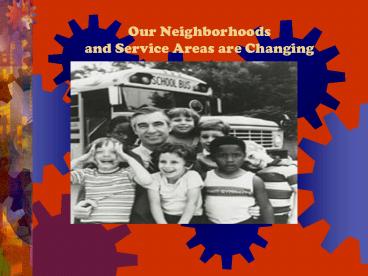Our Neighborhoods and Service Areas are Changing - PowerPoint PPT Presentation
Title:
Our Neighborhoods and Service Areas are Changing
Description:
Our Neighborhoods and Service Areas are Changing – PowerPoint PPT presentation
Number of Views:38
Avg rating:3.0/5.0
Title: Our Neighborhoods and Service Areas are Changing
1
Our Neighborhoods and Service Areas are Changing
2
- INFORMATION
- 911!
- Tracie D. Hall
- Dominican University GSLIS
- tdhall68_at_hotmail.com
3
Why has diversity become such a buzzword?
- John D. Rockefeller once said
- I will pay more for the ability to deal with
people than for any ability under the sun. - Twenty-first century libraries are beginning to
understand that the work of diversity is simply
the work of learning to deal with people, who
are often as different as they are the same.
Diversity and the lens of cultural competence
compels us to move beyond the old service mantra
of treat people as you wish to be treated and a
new service framework designed to make service
more meaningful and transformational for the
library user - Treat others as they wish to be treated.
4
DIMENSIONS OF HUMAN DIVERSITY
Accent Language Background Political Affiliation
Age Learning Style Race
Appearance Lifestyle Regional Background
Communication Style Mannerisms Religion
Economic Status Marital Status Religious Denomination
Education Mental Ability/ Mental Health Sexual Orientation
Ethnicity Nationality Size
Family Size/Makeup Occupation Skin Color
Gender Parental Status Values System
Income Level Personality Type Work Experience
Job Classification Physical Ability Work Style
5
Libraries Everywhere are Coping with Change
Finlands Infobank Project
- A service has been created through the Open
Learning Centre Project (Avoin oppimiskeskus
projekti) (yrs. 2001-2003) organized by the
International Cultural Centre Caisa
(Kansainvälinen kulttuurikeskus Caisa) in
cooperation with the Kelsinki City Library
(Helsingin kaupunginkirjasto). The project is
funded by the City of Helsinki and the European
Social Fund. http//www.infopankki.fi/default.asp - Select TopicWELCOME TO FINLAND
- PERMITS
- ACCOMMODATION
- FINNISH LANGUAGE
- WORK
- EDUCATION
- HEALTH
- SOCIAL SERVICES
- CRISES
- CULTURE AND LEISURE ASSOCIATIONS
Info Bank contains Important basic information
for immigrants on the functioning of society and
opportunities in Finland.
6
Increased Migration is adding to the diversity
and multiculturalism in the US
7
Assumptions and Values Voting
8
Issues of Access and Inequity that Impede
Diversity in Libraries
- Monolingual nature of library communication and
native language insularity of immigrant
communities. Kalyani Rai (2002) notes that 56 of
Asians do not speak fluent English and 35 live
in linguistically isolated households - Unfamiliarity with and Misperceptions of Library
Services (include fear of costs and fees) - Feelings of Inadequacy (language, cultural, class
or income level) - Past Experience of Exclusion or Poor Treatment
(new migrants may fear ill-treatment,
miscommunication, judgment) - Cultural, Social and Physical Barriers signage,
ADA, etc - Linguistic Barriers signage, absence of
multilingual staff, computer technology,
collections, programs, answering machine systems - Cognitive or Communication Preferences
Visual/Auditory/Kinesthetic - Library funding and staffing mirrors
socio-economic or political inequities - Feelings of Inadequacy
- Sanctioning identified patient treatment
To scale this wall, we need a committed workforce.
9
Ideas for Improving Public Library Services to
Diverse Populations
- Check yourself
- Reach out to community stakeholders working with
populations underserved by the library and look
for ways to establish partnerships. - Challenge the invited, but not included mode of
diversity work. - Look outside of libraries and at other businesses
for customer-service and best practice ideas. - Champion diversity as central (not tangential) to
customer service. - Remember the much quoted mantra If you dont
like change, youll hate irrelevancy. - Remember what happened when Rabbit tried to build
a house
10
(No Transcript)































